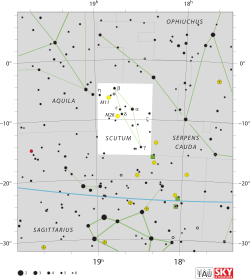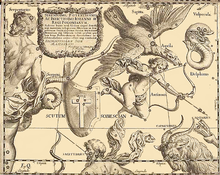Scutum (constellation)
| Constellation | |
 | |
| Abbreviation | Sct |
|---|---|
| Genitive | Scuti |
| Pronunciation | /ˈskjuːtəm/, genitive /ˈskjuːtaɪ/ |
| Symbolism | the Shield |
| Right ascension | 18.7h |
| Declination | −10° |
| Quadrant | SQ4 |
| Area | 109 sq. deg. (84th) |
| Main stars | 2 |
| Bayer/Flamsteed stars | 7 |
| Stars with planets | 1 |
| Stars brighter than 3.00m | 0 |
| Stars within 10.00 pc (32.62 ly) | 0 |
| Brightest star | α Scuti (3.85m) |
| Messier objects | 2 |
| Meteor showers | June Scutids |
| Bordering constellations | Aquila Sagittarius Serpens Cauda |
| Visible at latitudes between +80° and −90°. Best visible at 21:00 (9 p.m.) during the month of August. | |
Scutum is a small constellation. Its name is Latin for shield, and it was originally named Scutum Sobiescianum by Johannes Hevelius in 1684. Located just south of the celestial equator, its four brightest stars form a narrow diamond shape. It is one of the 88 IAU designated constellations defined in 1922.
History

Scutum was named in 1684 by Polish astronomer Johannes Hevelius[1] (Jan Heweliusz), who originally named it Scutum Sobiescianum (Shield of Sobieski) to commemorate the victory of the Christian forces led by Polish King John III Sobieski (Jan III Sobieski) in the Battle of Vienna in 1683. Later, the name was shortened to Scutum.
Five bright stars of Scutum (α Sct, β Sct, δ Sct, ε Sct and η Sct) were previously known as 1, 6, 2, 3, and 9 Aquilae respectively.[2]
The constellation of Scutum was adopted by the International Astronomical Union in 1922 as one of the 88 constellations covering the entire sky, with the official abbreviation of "Sct".[3] The constellation boundaries are defined by a quadrilateral. In the equatorial coordinate system, the right ascension coordinates of these borders lie between 18h 21.6m and 18h 59.3m , while the declination coordinates are between −3.83° and −15.94°.[4]
Coincidentally, the Chinese also associated these stars with battle armor, incorporating them into the larger asterism known as Tien Pien, i.e., the Heavenly Casque (or Helmet).[5]
Features
Stars


Scutum is not a bright constellation, with the brightest star, Alpha Scuti, being a K-type giant star[6] at magnitude 3.85. However, some stars are notable in the constellation. Beta Scuti is the second brightest at magnitude 4.22, followed by Delta Scuti at magnitude 4.72. It is also known as 6 Aquilae.[7] Beta Scuti is a binary system,[8][9] with the primary with a spectral type similar to the Sun, although it is 1,270 times brighter. Delta Scuti is a bluish white giant star, which is now coming at the direction of the Solar System. Within 1.3 million years it will come as close to 10 light years from Earth,[10] and will be much brighter than Sirius by that time.
UY Scuti is a red hypergiant pulsating variable star and is also one of the largest stars currently known with a radius over 1,700 times that of the Sun,[11][12] although some studies give lower estimates.[13] Stephenson 2 DFK 1 is another red hypergiant star and is possibly the largest star currently known, with a radius of 2,150 times that of the Sun.[14] Scutum contains several clusters of supergiant stars, including RSGC1,[15] Stephenson 2 (which contains Stephenson 2 DFK 1)[16][17] and RSGC3.[18]
Deep sky objects

Although not a large constellation, Scutum contains several open clusters, as well as a globular cluster and a planetary nebula. The two best known deep sky objects in Scutum are M11 (the Wild Duck Cluster) and the open cluster M26 (NGC 6694). The globular cluster NGC 6712 and the planetary nebula IC 1295 can be found in the eastern part of the constellation, only 24 arcminutes apart.
The most prominent open cluster in Scutum is the Wild Duck Cluster, M11. It was named by William Henry Smyth in 1844 for its resemblance in the eyepiece to a flock of ducks in flight. The cluster, 6200 light-years from Earth and 20 light-years in diameter, contains approximately 3000 stars, making it a particularly rich cluster. It is around 220 million years old,[19] although some studies give older estimates.[20] Estimates for the mass of the star cluster range from 3,700 M☉[21] to 11,000 M☉.[22]
Space exploration
The space probe Pioneer 11 is moving in the direction of this constellation. It will not near the closest star in this constellation for over a million years[23] at its present speed, by which time its batteries will be long dead.
See also
- Scutum (Chinese astronomy)
- Taurus Poniatovii - a constellation created by the Polish astronomer Marcin Odlanicki Poczobutt in 1777 to honor King of Poland Stanisław August Poniatowski.

References
- ^ Star Tales ― Scutum by Ian Ridpath
- ^ Wagman, M. (August 1987). "Flamsteed's Missing Stars". Journal for the History of Astronomy. 18 (3): 212–213. Bibcode:1987JHA....18..209W. doi:10.1177/002182868701800305. S2CID 118445625.
- ^ Russell, Henry Norris (1922). "The New International Symbols for the Constellations". Popular Astronomy. 30: 469. Bibcode:1922PA.....30..469R.
- ^ "Scutum, Constellation Boundary". The Constellations. International Astronomical Union. Retrieved 3 September 2020.
- ^ Richard H. Allen (1899) Star Names and Their Meanings, p. 363
- ^ Keenan, Philip C.; McNeil, Raymond C. (1989). "The Perkins catalog of revised MK types for the cooler stars". The Astrophysical Journal Supplement Series. 71: 245. Bibcode:1989ApJS...71..245K. doi:10.1086/191373.
- ^ Wagman, M. (August 1987). "Flamsteed's Missing Stars". Journal for the History of Astronomy. 18 (3): 212. Bibcode:1987JHA....18..209W. doi:10.1177/002182868701800305. S2CID 118445625.
- ^ Hutter, D. J.; Zavala, R. T.; Tycner, C.; Benson, J. A.; Hummel, C. A.; Sanborn, J.; Franz, O. G.; Johnston, K. J. (2016). "Surveying the Bright Stars by Optical Interferometry. I. A Search for Multiplicity among Stars of Spectral Types F-K". Astrophysical Journal Supplement Series. 227 (1): 4. arXiv:1609.05254. Bibcode:2016ApJS..227....4H. doi:10.3847/0067-0049/227/1/4. S2CID 118803592.
- ^ Parsons, S. B.; Franz, O. G.; Wassermann, L. H. (2005). "The Fine Guidance Sensor Orbit of the G4 Bright Giant HD 173764". Astronomical Journal. 129 (3): 1700. Bibcode:2005AJ....129.1700P. doi:10.1086/427853.
- ^ García-Sánchez, J.; et al. (2001), "Stellar encounters with the solar system", Astronomy and Astrophysics, 379 (2): 634–659, Bibcode:2001A&A...379..634G, doi:10.1051/0004-6361:20011330
- ^ Arroyo-Torres, B.; Wittkowski, M.; Marcaide, J. M.; Hauschildt, P. H. (2013). "The atmospheric structure and fundamental parameters of the red supergiants AH Scorpii, UY Scuti, and KW Sagittarii". Astronomy & Astrophysics. 554: A76. arXiv:1305.6179. Bibcode:2013A&A...554A..76A. doi:10.1051/0004-6361/201220920. S2CID 73575062.
- ^ Tabernero, H. M.; Dorda, R.; Negueruela, I.; Marfil, E. (2021). "The nature of VX Sagitarii". Astronomy & Astrophysics. 646: A98. arXiv:2011.09184. doi:10.1051/0004-6361/202039236. S2CID 227013580.
- ^ Messineo, M.; Brown, A. G. A. (2019). "A Catalog of Known Galactic K-M Stars of Class I Candidate Red Supergiants in Gaia DR2". The Astronomical Journal. 158 (1): 20. arXiv:1905.03744. Bibcode:2019AJ....158...20M. doi:10.3847/1538-3881/ab1cbd. S2CID 148571616.
- ^ Fok, Thomas K. T; Nakashima, Jun-ichi; Yung, Bosco H. K; Hsia, Chih-Hao; Deguchi, Shuji (2012). "Maser Observations of Westerlund 1 and Comprehensive Considerations on Maser Properties of Red Supergiants Associated with Massive Clusters". The Astrophysical Journal. 760 (1): 65. arXiv:1209.6427. Bibcode:2012ApJ...760...65F. doi:10.1088/0004-637X/760/1/65. S2CID 53393926.
- ^ Figer, D. F.; MacKenty, J. W.; Robberto, M.; Smith, K.; Najarro, F.; Kudritzki, R. P.; Herrero, A. (2006). "Discovery of an Extraordinarily Massive Cluster of Red Supergiants". The Astrophysical Journal. 643 (2): 1166–1179. arXiv:astro-ph/0602146. Bibcode:2006ApJ...643.1166F. doi:10.1086/503275. S2CID 18241900.
- ^ Davies, B.; Figer, D. F.; Kudritzki, R. P.; MacKenty, J.; Najarro, F.; Herrero, A. (2007). "A Massive Cluster of Red Supergiants at the Base of the Scutum‐Crux Arm". The Astrophysical Journal. 671 (1): 781–801. arXiv:0708.0821. Bibcode:2007ApJ...671..781D. doi:10.1086/522224. S2CID 1447781.
- ^ Stephenson, C. B. (1990). "A possible new and very remote galactic cluster". The Astronomical Journal. 99: 1867. Bibcode:1990AJ.....99.1867S. doi:10.1086/115464.
- ^ Negueruela, I.; González-Fernández, C.; Marco, A.; Clark, J. S.; Martínez-Núñez, S. (2010). "Another cluster of red supergiants close to RSGC1". Astronomy and Astrophysics. 513: A74. arXiv:1002.1823. Bibcode:2010A&A...513A..74N. doi:10.1051/0004-6361/200913373. S2CID 118531372.
- ^ MacRobert, Alan (September 2012). "So, Where Are the Wild Ducks?!". Sky and Telescope.
- ^ Casamiquela, L.; et al. (March 2018), "NGC 6705 a young α-enhanced open cluster from OCCASO data", Astronomy & Astrophysics, 610: 10, arXiv:1710.11069, Bibcode:2018A&A...610A..66C, doi:10.1051/0004-6361/201732024, S2CID 59397264, A66.
- ^ Cantat-Gaudin, T.; et al. (September 2014), "The Gaia-ESO Survey: Stellar content and elemental abundances in the massive cluster NGC 6705", Astronomy & Astrophysics, 569: 18, arXiv:1407.1510, Bibcode:2014A&A...569A..17C, doi:10.1051/0004-6361/201423851, S2CID 5111744, A17.
- ^ Santos, J. F. C. Jr.; et al. (October 2005), "Structure and stellar content analysis of the open cluster M 11 with 2MASS photometry", Astronomy and Astrophysics, 442 (1): 201–209, arXiv:astro-ph/0507216, Bibcode:2005A&A...442..201S, doi:10.1051/0004-6361:20053378, S2CID 15323948.
- ^ Pioneer 11 is travelling at ~2.4 au/yr, 41.54 ly ≈ 2.627x106au.
Sources
- Ian Ridpath and Wil Tirion (2017). Stars and Planets Guide (5th ed.), Collins, London. ISBN 978-0-00-823927-5. Princeton University Press, Princeton. ISBN 978-0-69-117788-5.
External links